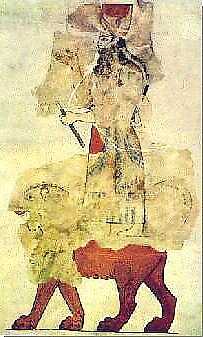Hall One: Empire and Cuneiform

| Erebuni Museum |
|
Hall One: Empire and Cuneiform |
 |
 Tesiheba |
Section 1 1C. Bas Relief of Khaldi. Reconstruction in tuf stone. The two bas relief's in tuf stone are contemporary carving based on fragments found at the excavation. The one on the left (1A) is the god Teisheba and the one on the right (1C) depicts the god Khaldi. There were 79 gods in the Urartian pantheon (14 female, and 65 male). The three main deities were Khald (or Khaldi, the supreme god, symbolized by a man standing on a lion), his wife wife Arubani, and Teisheba (a fighting god symbolized by a man standing on a bull). Others in the pantheon included Khuba (the god of war), Shivini (the sun god, depicted as a fireball) and Tushpue (he god of the Urartian capital Tushpa). 1B. Map of Urartu Empire. In the center of the two bas relief is a large wall map of embossed metal showing the Urartu Empire at its greatest extent. On the map towards the right, you can notice three lakes. The largest lake is Van, the others Sevan and Urmia. Urartians called their country (and themselves) Biaini (Biainili). The words "Biain" and "Van" are not that far removed: several centuries of dialect pronunciations have softened the "b" to a "v" and changed the diphthong "iai" to a short "a" sound. The name "Urartu" comes from Assyrian and Babylonian descriptions of the Urartians, using their own coined term, and archeological and historical researchers adopted it in the modern age. 1D.
Model of Erebuni. Underneath the map is a model of Erebuni
as it was first built, including the temples of Sushi and Khaldi, a Ziggurat
(in Armenian "Ashtarak") or watch tower within the layout. The walls were
between 12-15 meters in height (40-50 ft), with an average thickness of between
2-4 meters (6.5-13 ft). The royal entourage and soldiers lived
at the highest point (the most fortified section) of the city, while urban
dwellings rung the hillside below and around the citadel. |
|
Section
2
2A-H.
Cuneiform Stones. The
next section houses a selection of cuneiform storms in Urartian, Babylonian
and Assyrian writing. Urartu adopted cuneiform from the Assyrians and
Babylonians along with other traditions and beliefs.
From all excavations in Armenia since 1950, more than 500 cuneiform stones were discovered; the majority at Teishebaini (Karmir Blur, Yerevan) and Argishtikhinili (Armavir). 20 were found at Erebuni. The
feature of the cuneiform room is the tablet bearing the inscription by Argishti
I proclaiming the birth of Erebuni "to declare the might of the land of
Biaini and hold her enemies in awe". |
 Cuneiform |